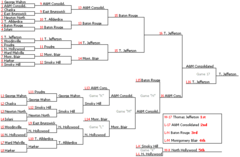| Revision as of 13:22, 18 June 2012 editRobofish (talk | contribs)Extended confirmed users, Pending changes reviewers, Rollbackers99,579 edits added unreferenced template, removed link to deleted article← Previous edit | Revision as of 10:51, 7 July 2012 edit undoSoerfm (talk | contribs)Extended confirmed users14,219 edits →Examples: SizeNext edit → | ||
| Line 19: | Line 19: | ||
| ==Examples== | ==Examples== | ||
| <gallery> | <gallery widths=240 heights=200> | ||
| File:SixteenPlayerSingleEliminationTournamentBracket.svg|A 16-player, single-elimination tournament bracket. The quarterfinals have been completed, and the semifinal games will be Lisa vs. Ernie, and Andrew vs. Robert. Then the finals will be a game between the two people who win in the semifinals. | File:SixteenPlayerSingleEliminationTournamentBracket.svg|A 16-player, single-elimination tournament bracket. The quarterfinals have been completed, and the semifinal games will be Lisa vs. Ernie, and Andrew vs. Robert. Then the finals will be a game between the two people who win in the semifinals. | ||
| Image:NSB-doubleelim-draw-2004.png|A double elimination bracket from the ] national ] | Image:NSB-doubleelim-draw-2004.png|A double elimination bracket from the ] national ] | ||
Revision as of 10:51, 7 July 2012
| This article does not cite any sources. Please help improve this article by adding citations to reliable sources. Unsourced material may be challenged and removed. Find sources: "Bracket" tournament – news · newspapers · books · scholar · JSTOR (June 2012) (Learn how and when to remove this message) |
A bracket is a tree diagram that represents the series of games played during a tournament, named as such because it appears to be a large number of interconnected (punctuational) brackets.
There are several kinds of brackets, adapted to different types of tournaments. The most common are:
- Single elimination brackets
- Double elimination brackets
The "art" of filling in brackets, especially in NCAA basketball, is referred to as bracketology.
Usage in North America
Brackets are commonly found in major North American professional sports leagues. Often, at the end of the regular season, the league holds a post-season tournament (most commonly called a playoff) to determine which team is the best out of all of the other teams in the league. This is done because often in professional sports there are at least two different conferences, and teams mostly play other teams in their own conference. Examples of this are the American Football Conference and the National Football Conference in the NFL, the American League and the National League in Major League Baseball, and the Eastern Conference and the Western Conference in the NBA or NHL.
When there are only two different conferences, there are two sides of the bracket. One conference is on one side, while the other is on the opposite side. Teams that qualify for the post-season tournament only compete against teams in their own conference, until only one team from each conference remains. These two teams, called the conference champions, play each other to determine the best in the league. Other leagues, like the NHL, have two conferences, each of which is divided into divisions, usually by region. In the post-season tournament, only the teams with the best records qualify, with the exception of the division leader having an automatic entry into the tournament.
Most North American professional post-season tournaments are single-elimination format. If a bye is required, the top seeded teams usually get the bye. There is usually no third place match to separate the third and fourth place teams.
Examples
-
 A 16-player, single-elimination tournament bracket. The quarterfinals have been completed, and the semifinal games will be Lisa vs. Ernie, and Andrew vs. Robert. Then the finals will be a game between the two people who win in the semifinals.
A 16-player, single-elimination tournament bracket. The quarterfinals have been completed, and the semifinal games will be Lisa vs. Ernie, and Andrew vs. Robert. Then the finals will be a game between the two people who win in the semifinals.
-
 A double elimination bracket from the 2004 national Science Bowl
A double elimination bracket from the 2004 national Science Bowl
-
 A triple-elimination tournament.
A triple-elimination tournament.
-
 Australian Football League finals incorporating a bye for the highest two seeded, first round winners.
Australian Football League finals incorporating a bye for the highest two seeded, first round winners.